What comes to your mind when you think of a massive, prosperous company? A carefully planned marketing strategy? Quality customer service? Excellent product quality? Greatly designed website? Successful large companies consider all of these points.
Well, ecommerce UX strategy includes everything we’ve talked about above. That’s why many companies involve UX designers in the company’s growth process. However, nowadays, UX design for ecommerce is not just about the well-placed button, but about the whole product that will deliver the user to the goal in a few steps.
Ecommerce UX strategy is not just about aesthetics; it is a vehicle for attracting, engaging, and retaining customers. It affects design and branding and the success of the entire eCommerce marketing strategy. Therefore, adhering to a well-chosen ecommerce UX strategy is essential to success. In this article, we will talk about UX strategies that would help your business to prosper.

What is UX Strategy?
“UX strategy is the intersection between user experience design and business strategy.” Jaime Levy - UX guru
UX design involves creating the product. And the UX strategy provides the plan. With it, businesses can find out how to keep users’ expectations and experience with a brand in line with the overall goals and expectations of the company.

User experience strategy allows businesses to prioritize their resources so that they won’t spend them on non-essential things during the development process. In addition, it helps ensure that businesses’ vision, user needs, and technical capabilities are aligned to resolve the correct problems for targeted users.
To make this term more understandable, we can divide it into six principles that work together to make the strategy more effective:
-
Business strategy
These are the main principles of the company, as well as its competitive advantage, business goals, and expectations. It also includes brand positioning.
-
Unique Selling Proposition (USP)
It is why customers chose you among the others. Companies strive to achieve innovative value while striving for customer value at a low cost. A UX strategy helps accomplish this goal.
-
User research
It is an integral part of the strategy. Instead of making assumptions, it is better to conduct user interviews and research to understand what is essential to its clients. Thus, you can reduce development costs by not creating what users do not need. Read more about the methods of research in our previous article.

Essential UX Research Methods For Your Business
-
UX design
UX design should bring pleasure to the client and ensure that they can quickly achieve their goal. According to statistics, 88% of online shoppers say they wouldn’t return to a website after a terrible user experience.
-
UI design
People like pretty things. Moreover, they are more likely to buy something from a website that looks pleasant than outdated ones.
-
Marketing strategy
No matter how well everything is implemented in other aspects, people need to learn about your product. Without marketing, you will simply bury your product in obscurity.
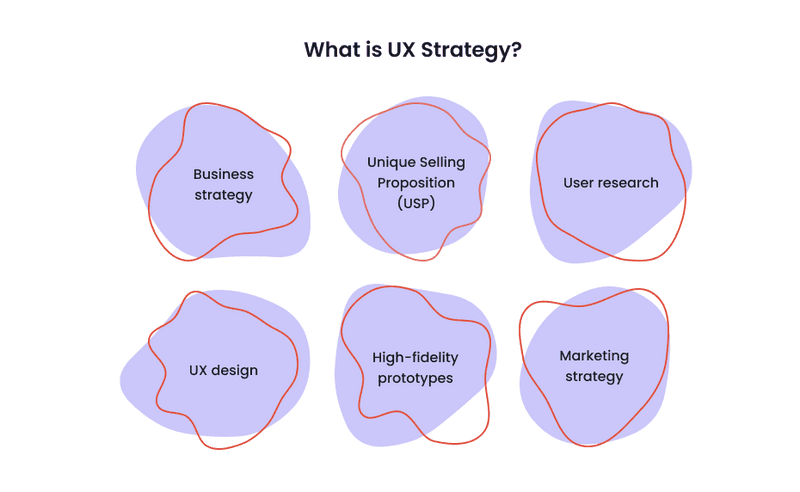
UX strategy is a complex term encompassing visual and UX design and marketing strategy. Along with this, you can build a great plan to attract and retain customers. It can also correct the current path of your business.
For now, we understand what UX strategy is. But still, what are the pros of it for business?
Why is UX Strategy Important?
Let’s see why UX strategy is so important, whether you have it or not. You may have a UX strategy, and you just don’t call it that. With a UX strategy, your team has a clear understanding of what actions to take to attract new customers and retain old ones. As a result, your company’s resources are not wasted on unnecessary activities, and your marketing strategy works seamlessly along with a well-designed UI/UX of your website. Sounds familiar? Congrats, you already have a plan for company growth.
But that is not all benefits that UX strategy can give to your business, so we’ve gathered some more to show you the effectiveness of this undertaking:
-
Alignment
A UX strategy helps synchronize business goals, technical capabilities, and user needs into a single set of tasks. As a result, it makes it easier to prioritize and not waste resources on useless things.
-
Clear metrics of success
Goal setting provides a clear understanding of what success should look like. To make it, gather and analyze data about average session time, number of failures, NPS, average check, etc. Thus, you will know how to measure it from the very beginning. And this dramatically simplifies the assessment of the impact of design decisions on the promotion of a product in the right direction.
-
User-centered mentality
User research, which is part of building a UX strategy, gives your team a clear vision of what users need. Thus, their work is built around these needs, resulting in a great product.
-
Connection
A UX strategy helps you see all the touchpoints of a user with your product or brand. This way, you can work through them and achieve success.
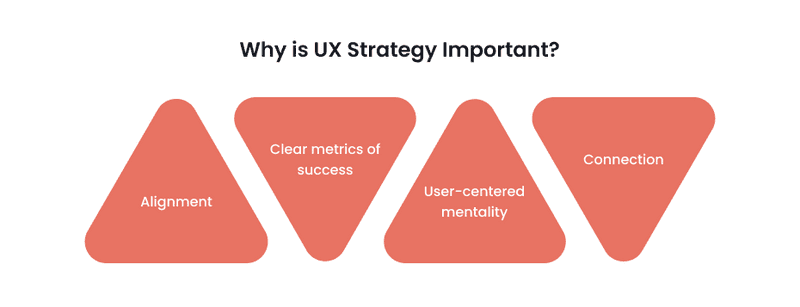
It is all great, but what exactly is the appeal of UX strategies for e commerce business? If you still have no idea, then read the next paragraph.
Why is Ecommerce UX Strategy vital?
Since UX strategy covers all areas of business promotion, this is important for ecommerce. With a well-designed strategy, you will perfectly understand your customers, which means you will know what they need and what they should pay attention to retain them and bring new ones.
Of course, UX strategy is most effective for startups initially. Indeed, you will correctly allocate the budget for developing a website or application in this way. However, it will also help build a brilliant marketing strategy, equally important for a business. When you plan development, you make a roadmap: you arrange various activities, deadlines, and dependencies of one task on another. UX strategy is the same, but it helps set up departments’ work and synchronize them throughout the company.
To get an even better understanding of what a UX strategy is, you can go back a bit to the basics.
What is Ecommerce UX?
UX strategy covers all interactions between your business and customers. It is called CX (Customer Experience). Thus, ecommerce UX covers all the interactions a customer makes in purchasing a product. The customers’ journey starts with visiting a website or app and goes beyond buying a product.
Post-purchase interactions include product delivery, customer support, product returns or exchanges, and so on. In short, anything a customer can do with an online store falls within this term. Likewise, any other touchpoints are a part of CX.
But still, why is it important? What exactly is included in this concept, and how does it affect customer retention and attraction of new ones?

Why is eCommerce UX Important?
Jeff Bezos, CEO at Amazon, says: “If you do build a great experience, customers tell each other about that. Word of mouth is very powerful”. Yes, because the statistics say that 44% of shoppers will tell their friends about a bad online experience.
Moreover, most online stores sell products that can be purchased from any other e-commerce store. In this regard, even the prices of a product or service may be similar. As a result, e-commerce businesses are forced to take a fiercely competitive path.
But how to differentiate yourself from other similar businesses? The answer is that the only thing that differentiates online stores right now is the kind of ecommerce user experience. It propels one eCommerce business ahead of others in terms of success.

Poor e commerce user experience drives customers away and is one of the main reasons for not buying a product or service. No matter how aesthetically appealing your product or website is, it doesn’t make sense if it doesn’t help drive sales. Moreover, ecommerce UX design indirectly affects SEO: if your site is inconvenient and new visitors don’t understand navigating it, they won’t come back to you again.
But there is one more point: you can provide the best user experience on the site, but they will not come to you with bad marketing. Conversely, you will attract clients, but they will not reach the checkout due to poor UX. But the UX strategy allows you to smooth out all these corners and fully develop your business.
Critical Points to Successful UX in eCommerce
Now, do you understand why, without a well-designed e-commerce UX part, almost any web product would be useless? Great, now is the time to find out what factors determine how good the UX of your eCommerce solution is.
-
Utility
It means how quickly the user reached the target action and whether he could reach it at all. Typically, this criterion is essential when a user is first introduced to an e-commerce solution. It is where Hick’s law works: the time it takes to decide increases logarithmically with the number of options.
The more options you have, the longer you choose, and if there are too many options, then the amount of information required for analysis will be too large. Don’t force users to take too many steps towards their goal.
-
Accessibility
How fast do pages load for the user? Can the product be accessed from a mobile device? Is it possible to get to the website from different browsers? You will have to answer these and many other questions to determine if your product meets the criteria for availability.
-
Desirability
It is, most of all, the visual component of the product. It is determined by the user’s desire to use the product. According to Forrester, Better UI could raise your website’s conversion rate by 200%, and better UX design could yield conversion rates of up to 400%.
-
Usability
E commerce usability means the convenience and simplicity of user interaction with the web solution. According to Uxeria, 70% of online businesses fail because of bad usability.
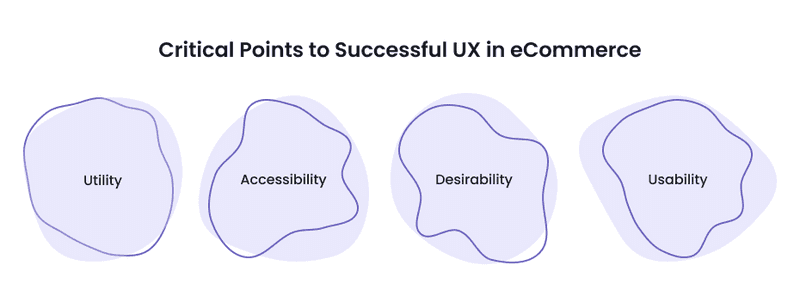
Now, you know what UX strategy is and why e commerce UX is important. If you want to learn more about the process of eCommerce product creation, read our previous article, where we talked in detail about the UI and UX aspects of this topic.

The Anatomy of a Great E-commerce Website Design
Tips for Creating UX strategies for E commerce Business
To understand how to provide the best user experience, we’ll look at the most crucial UX strategies for e commerce business. These will help you build a great plan to capture the e-commerce market. We have already prepared you for this information with the details above.
Focus on Customers
Yes, you have heard about this before, but we will not tire of repeating it. According to statistics, customer-centric businesses are more profitable by up to 60% than companies that don’t care about it. So, what can you do to make it? We have a few ideas:
-
Omnichannel strategy
This strategy is one of the ecommerce user experience best practices. It is about the eCommerce marketing strategy that provides a seamless customer experience across different channels. So if a shopper chooses items on your mobile app but prefers to checkout on your website, the experience should be consistent.
This strategy empowers your audience and allows them to personalize their experience with your brand. Therefore, they are more likely to come back to you, recommend you to friends, and become regular customers.
Amazon is an excellent example of multi-channel support in the e-commerce space. It has an app and website that automatically syncs users’ carts when users log in, making the shopping experience easier. In addition, unlike competitors, they allow users to start shopping on one device and continue on another. As a result, they increase conversion and remind of purchases already on the smartphone using push notifications.
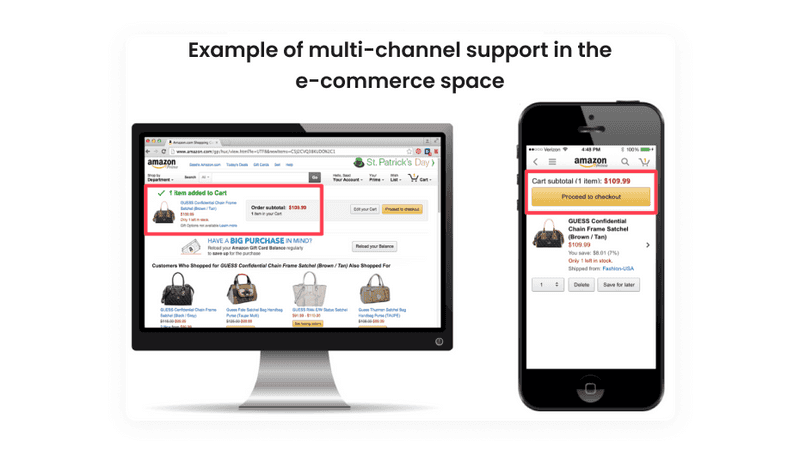
-
Accessible customer support
The best competitive advantage that can help win customers is efficient and easily accessible omnichannel support.
Make support channels visible on your platforms. Let your users feel that they have access to expert help in the most convenient way. It can be a chatbot, email support, call center, or live chat.
Again, Amazon is an excellent example of accessible customer support. They provide users with various customer support methods to quickly choose the most suitable one. So, if there are some issues on the website, customer support will promptly be soothed.
-
Personalize customer experience
Put the information you collect to good use. Hyper-personalization is something you should aim for at every step of the ecommerce user flow. It will help you select more successful and relevant content and give you an understanding of which direction of products and services you should move. Consequently, you get higher conversions and better sales overall.
For this strategy, Timberland is an excellent example. They use near-field communication technology in their stores, giving shoppers a tablet that can be held up to merchandise and signage throughout the store.
When the tablet is brought close to the chip, it displays information about that product or offer. As a result, shoppers don’t have to search in-store for more details and can easily see the deals for each item.
As shoppers search for various items, the personalization software on the tablet will suggest products to the user based on their purchase history. It creates a more personalized experience for the customer and can draw customers’ attention to products that may not be very popular.
In this part, we have analyzed various strategies related to buyers. As you may have noticed, success in eCommerce depends on how well you know your users. But what else can be important when building an ecommerce UX strategy?
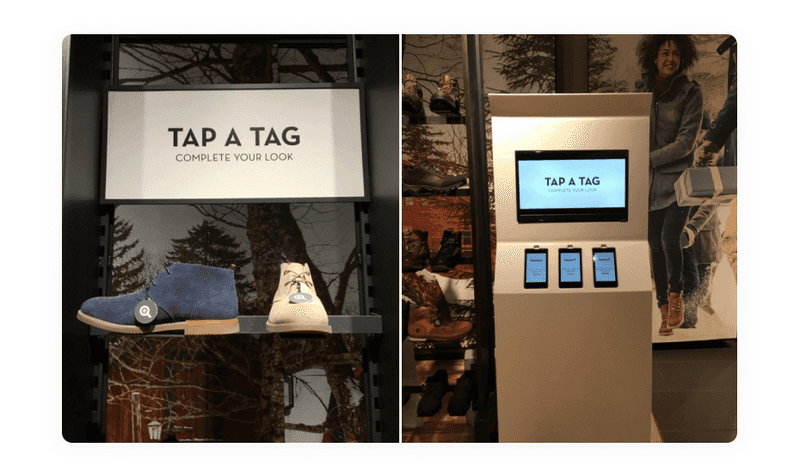
Define Business Strategy
Determine what goals you want to achieve and what vision you have for your business. Next, it is necessary to build competent branding and positioning. Finally, think about how you would like your customers to perceive you and move in that direction.
It is essential to conduct user research to understand which specific user you need to try. If you target a particular target audience, learn from the main pain points and consider how your business can solve these problems.
A clear business strategy will give you an understanding of building marketing campaigns. For example, it is not vital to have a good product and a good promotion in the digital age because otherwise, no one will know about it.

For example, now many stores will promote their applications. The buyer takes the product from the shelf, puts it in the basket, scans the barcode, and pays with a card tied to the app. Thus, businesses increase the purchase speed and check because of the likelihood of a spontaneous purchase increases. It is a UX, CX (Customer Experience), business strategy, and marketing bundle. Also, in such applications, buyers often give bonuses, which makes users download it. But it is not all. Want to know more?
Mobile Optimization
According to Visually mobile UX statistics, 85% of adults think a business’s mobile website should be as good as or better than its desktop equivalent. Users want you to optimize your product for mobile devices. The audience prefers companies that pay attention to what phone users need. If your website is still not optimized for this purpose, it might be time to consider taking it to the next level. Our last project (MIGIS) showed that 73% use mobile devices for eCommerce products.
Walmart is an excellent example of increasing sales by moving to mobile. E-commerce makes up 2.8% of their total sales, but they have done better by combining the in-store shopper experience with the mobile experience.
In 2017, the company invested in user experience optimization by redesigning its website, focusing on order summary UI, shopping cart UX design, and checkout services specific to certain regions or users’ preferred locations. The results speak for themselves. The company saw a 40 percent increase in e-commerce sales, according to SailThru. Much of this success has been due to the mobile app.

According to Think With Google, 96% of consumers have come across sites that weren’t optimized for mobile at all. Therefore, it is vital to have an excellent mobile version of your website in the digital era. Furthermore, mobile optimization affects the strategy and e commerce usability as it allows you to use your products in different conditions: transport, travel, queues, etc. Therefore, сonsider incorporating click-to-scroll buttons, sticky headers and footers, and wisely use pop-ups.
Also, think about good optimization because if customers go to a website that doesn’t load properly, they’re likely to give up on your brand completely. It would be a pity if you lost your money because of this. But what else matters when it comes to the UX strategy?
Use Psychological Tactics
Specific psychological tactics can drive people to buy your products or respect your brand. In the digital world, these are also known as persuasion triggers. It is proven that they are working and making conversion rates higher. Let’s take a closer look at some of them:
-
Social proof
Social proof in your website banners and emails can help shoppers move from looking at a product to buying, ultimately leading to higher conversions on your eCommerce website. According to BrightLocal, 95% of 18-35-year-olds read reviews before buying something. That is a huge number, right? Yet, social proof affects the human instinct to follow the action of others, so it lowers the barriers to making online purchases.
-
Cause a sense of lack and urgency
You may have seen this trick on the other eCommerce websites like Amazon. Products tend to become more attractive when people see few of them left. Therefore, It pushes for a faster purchase or purchase in general. So if you have a limited supply of certain products, be sure to let your customers know. A simple “5 left” flag can spur the casual visitor into action. Yet, the “sale” section may give the visitors the feeling that it is the last chance to buy a specific product.
-
Clear return policy
According to Nobel laureate economist and psychologist Daniel Kahneman, people fear loss far more than value gain. For eCommerce, this loss aversion can seriously hurt sales. Therefore, many e-commerce companies offer a favorable return policy that gives the buyer the impression of limited risk to solve this problem. Make the return policy prominent on your site to remove any doubts from your customers.

You can talk about psychological techniques endlessly, but what about the rest of the points that help build a UX strategy?
Optimize for High-Load Speed and Accessibility
While every UX strategy needs to be tailored to a specific organization, nearly all businesses need to keep loading speed and accessibility in mind. Loading speed dramatically affects the user experience and, therefore, should be a high priority in your UX strategy.
Today’s consumers love everything to load quickly and judge the quality of a product or service by how fast and smooth it runs.
Also, while your designs should be tailored to your primary user persona, it’s essential to keep accessibility guidelines in mind so that you don’t close out any potential users. Finally, don’t forget about people with specific vision or hearing problems.
Run Experiments and Iterate on the Results
Developing a dream product that users love often requires a willingness to experiment and fail. It is sporadic that something works out the first time. Let your UX strategy guide your design actions and decisions as you work on your design. It is because in-depth user research is carried out during the development of the strategy, which significantly influences the design. We will not tire of repeating that people ignore design that ignores people.

Keep checking both the strategy and your design as you work. Create a minimum viable product (MVP), test it with real users, and improve it based on feedback. After all, with a well-thought-out business plan and marketing strategy, your design will be perfect for your target audience, and conversions will break all records.
How UX Strategy Impacts Design
UX strategy, which includes business and marketing components, and design and research, has a significant impact on UX / UI ecommerce design. For example, it dictates which features to include on the site, which colors to use, which CTAs will be most effective, and how best to place them.
It can seem impossible to connect something as vague as a business vision to something as specific as a UX roadmap. But it’s worth trying because once the user experience is aligned with the company’s overall vision, the next rational step for the company is to provide the resources to make that vision a reality.
E-Commerce UX Design Mistakes
In pursuing better UX and ecommerce design trends, companies often make many mistakes that can be very significant. Let’s look at a few of the main ones:
-
Too many pop-ups
A couple of years ago, pop-ups were a popular method of increasing website conversions. But times have changed, and now it is essential to give the user maximum freedom of choice and action. By using a lot of pop-ups, you risk losing customers who will be turned off or too annoying.
-
Trying too hard to stand out
Often a business owner wants to stand out from their competitors specifically. But this does not always lead to good results because the final product may be too unusual and incomprehensible to the user.
Of course, this can work in some cases. If you know your customers well and understand that they love unusual things, then non-trivial ecommerce UI design can play into your hands. But in most cases, it’s better to rely on proven visual design techniques. Again, everything depends on user research and users’ needs.
-
Fishing for feedback too soon
To understand what potential buyers want, e-commerce websites often host various forms for collecting feedback. But you should be careful with them and not overdo it. Imagine: a user has just registered on your website, filled out specific forms, and then a new offer immediately pops up for him. It can annoy users.
-
Difficult to understand navigation
Navigation is the foundation. If your customers can’t figure out how to use and find anything on your site, your beautiful product photos and fast-loading website mean nothing.
Asos is an excellent example there. Their ecommerce navigation UX is easy to understand for the user. In addition, the site has images on the menu to illustrate what customers are looking for, which increases accessibility.
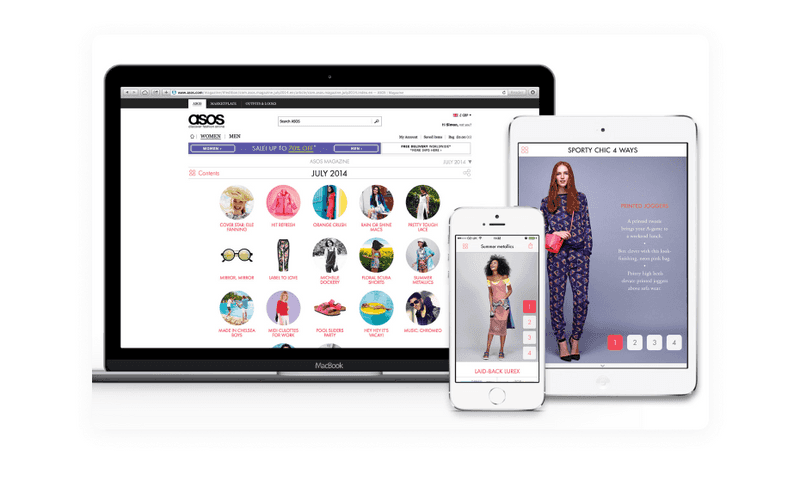
-
Lack of filters
It affects e commerce usability in the wrong way. Users may feel frustrated and go to your competitor’s website. When working on it, think about using the words your customers use when naming categories and make it easy to find, add or remove filters.
There, Asos also provides an excellent example of setting up a website filtering system. The design is straightforward. The Asos’ ecommerce filter UX system shows the user what is available based on their choice, allowing them to understand what to expect.
The menu and filtering options are also well optimized for mobile devices. Of course, an e-commerce site must work well on all devices to not lose customers. Yet, they provide customers with excellent ecommerce app design, which also affects conversion rates.
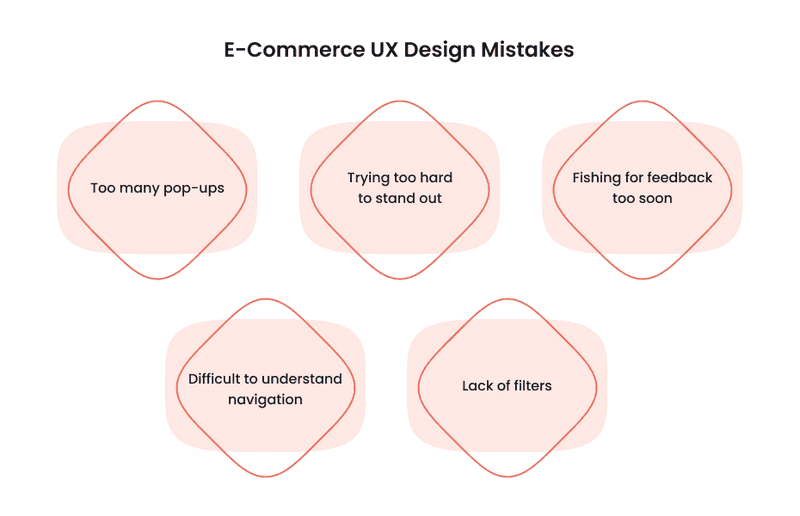
With the knowledge gained, you know exactly what a UX strategy is, why it is needed, and what mistakes can be made in design or user experience when designing a website. If you find that your product has some of the above errors, this is not a reason to be upset. Instead, this is your push to improve.
Conclusion
When you know your goal, you understand how to achieve it, which means that you are much more likely to achieve what you want than if you blindly ran in circles, hoping to achieve your aim. A UX strategy will help you develop a clear plan of action, thanks to which your resources will not be wasted, and you will hit the bulls-eye.
If you have an e-commerce startup or company, our specialists are always ready to help you. Our team has extensive experience working with startups and businesses of various sizes and different market segments. Remember that improving UX design and implementing UX strategy early on will save you resources in the long run. So don’t hesitate to invest in it. And our team will make sure everything goes smoothly.


